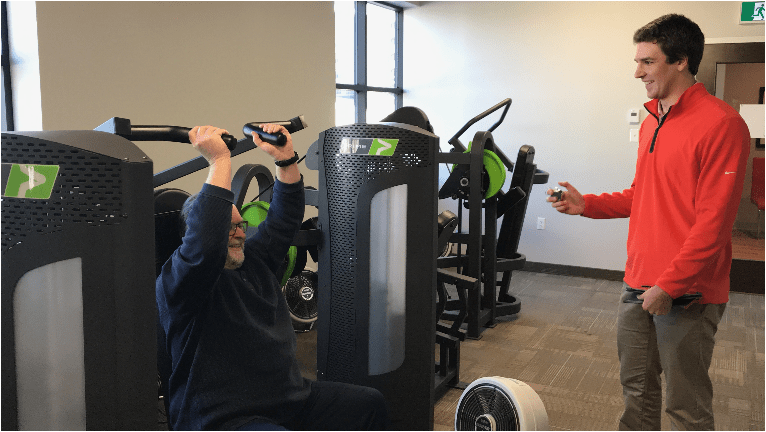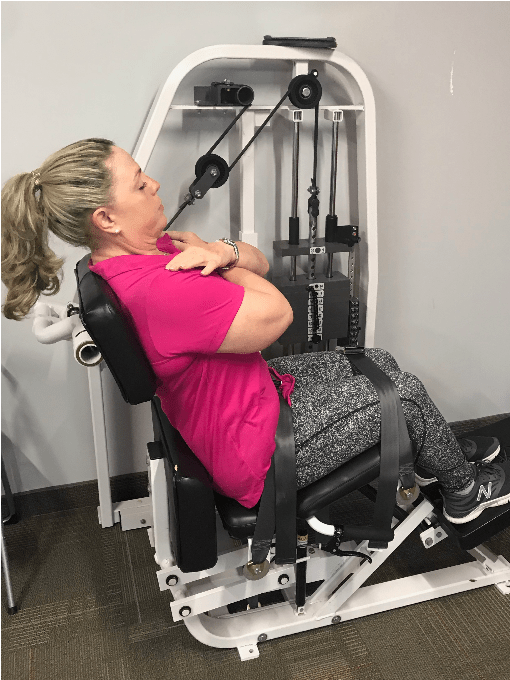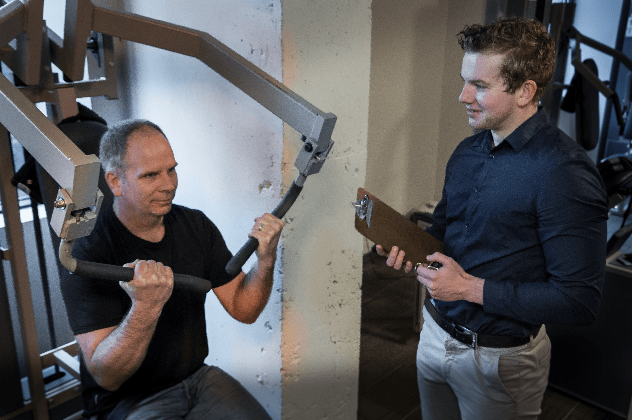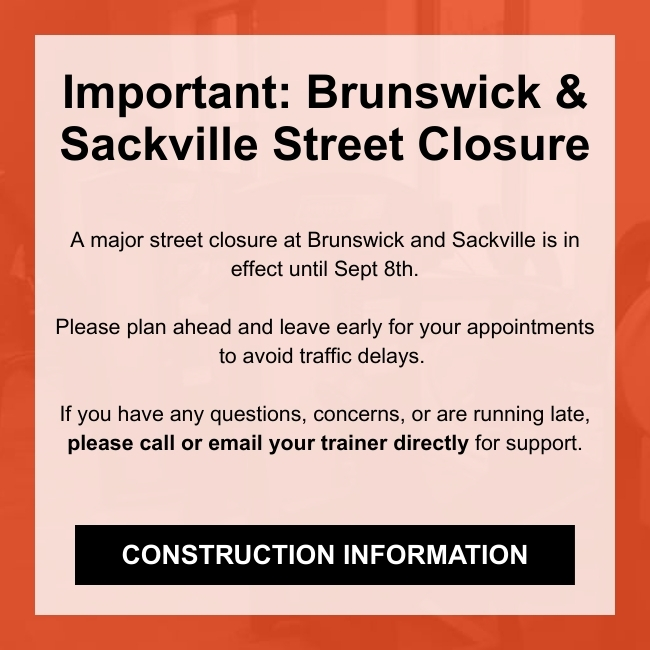Proper exercise is a learned skill. It must be carefully taught, cautiously practiced, and performed with great focus and concentration. Learning how to perform proper exercise is a step-by-step process that takes some time to master. This article will give you some guidelines to follow and points to think about during your training sessions to ensure that you are getting the most out of your workouts here at OneUp Fitness.
Preparation
It is common for people to enter the gym, get in a machine and just start moving the weight up and down without any thought or focus on what they are actually trying to accomplish.
We encourage our clients to show up about 5 minutes early. This way they can get changed and take 2 minutes to sit and mentally prepare for their workout. Proper exercise requires focus and concentration to achieve maximum benefits.
It is also important to understand that the objective of exercise is to safely fatigue the target
muscles to an optimal level. The best way to accomplish this is by moving the weights in slow motion; paying perfect attention to form; using the guidance of an educated and experienced coach; in a well designed machine; and focusing on contracting the target muscles throughout the entirety of the movement.
The Learning Curve
Your first few sessions will require you to focus on your form with the greatest attention to detail. Your trainer will coach you through every step of the way, expediting this process significantly. You don’t have to worry about trying to figure out what settings to use in the machines, what resistance to select and how many repetitions (reps) you should do; your trainer will do all of this for you. This allows you to spend more time focusing on the quality of the exercise you are performing, which will ensure that you maximize the result from your work in the exercise studio.

The exercises will be performed with the utmost attention to detail. Starting out, the weights will feel relatively light, allowing you to focus more on your form until you’ve perfected each of the movements in your routine. Too much weight at the beginning of a program interferes with your ability to learn how to perform the movements safely and efficiently. The first few workouts will not feel overly challenging; this is intentional. How quickly you learn proper form depends, and it is different for everyone, however, generally by the 5th or 6th session most people will become more efficient and confident in their movements.
How to Perform Proper Resistance Exercise
Tip #1: Moving slowly is the safest and most productive way to exercise.
Every rep counts. A proper rep will be performed perfectly. A slow lifting cadence, aiming for about 6 to 10 seconds just to lift the weight; then 2-3 seconds to change directions; and then 6 to 10 seconds to lower the weight is the most effective approach. This slow lifting pace will ensure that you are, first and foremost, safe because you will not be using excessive force. It also ensures that the muscles stay under tension, maximizing the benefit from your workout.
Tip #2: Breathe freely and continuously for improved performance

We suggest not holding your breath. Instead, attempt to breathe continuously while you perform your repetitions. Relax your jaw, face and neck and attempt to breathe through your mouth. It should feel like you are saying “ah, ha” with your breath. This helps you to remove carbon dioxide (CO2) out of; and will bring more oxygen into your working muscles. During your first few reps, your breathing will be light and feel natural. As the exercise becomes more challenging your breathing will, and should, become more laboured.
As you become more advanced, you will notice that you may actually start to pant heavily nearing the end of your set due to the increased demands on the working muscles. This is because resistance exercise also stimulates and improves your cardiovascular conditioning. When your breathing starts to become laboured, regardless of the exercise you are performing, you are now training and improving your cardiovascular conditioning. In other words, strength training IS ‘cardio’.
Tip #3: Anticipate and embrace muscular burning and discomfort
The Stress Response
This may sound counterintuitive however, the discomfort you will feel in the working muscles is a necessary side effect from proper exercise. It is not, in and of itself dangerous; although it may feel that way if you’ve not experienced it before. What makes exercise dangerous is improper form and excessive speed when performing repetitions. The most challenging repetitions of a set of exercise are the most important ones. This was mentioned earlier, but is worth repeating: the objective of proper exercise is to deeply fatigue the target muscles in the safest manner possible.
Without this discomfort we will not be addressing all of the muscle fibres within that group of muscles, making the exercise much less productive. We often talk about the idea that the quality (how you do it) of your exercise is more important than the quantity (how much you do). We have to stress our muscles (and bones!) in order for them to become stronger. Anything less than what feels very challenging will not produce the optimal result.
Over time and with practice, you will learn to lean into the discomfort (also a metaphor for life!) and, as your physical conditioning improves, you will better be able to handle the stress response that comes along with the hard, but necessary, muscular work.

Dealing with the Stress Response
There may come a time when you reach what we refer to as MMF or “Momentary Muscular Failure”. This, admittedly, sounds scary however, you’ll learn that it’s really not anything to be worried about.
“MMF” is when you are attempting to perform another repetition but you cannot. You try your hardest but you cannot complete the rep because your muscles are fatigued. According to the most current scientific literature on the topic of exercise: This is the optimal way to train whether you are 12 or 102 years old. The reason this approach is desirable is because whenyou reach MMF the majority of the muscle fibres in those working muscles are fatigued.
This event is a big stimulus to your body and your body will adapt to that stimulus by getting stronger, more capable muscles, bones, tendons and ligaments; as well as many other physiological benefits that are associated with this way of training. These adaptations happen when you rest and recover.
This approach to training is incredibly safe because we are moving slowly with perfect form. And, by the time you reach your final repetition, your muscles are quite fatigued meaning that you cannot produce enough force to injure yourself so long as your form is perfect. You should understand that the most dangerous repetition is your first one because you are 100% fresh and can produce your maximum amount of force. **All the more reason to take that very first rep slowly!
Dealing with the stress response starts with fully understanding this process. Knowing that fatigue and muscle burning is not dangerous gives us peace of mind and allows us to really challenge ourselves to work as hard as we can.
Breathing; keeping your face and neck relaxed; and remaining calm and focused helps substantially to overcome the stress response in exercise. Holding your breath will increase the stress response, making it feel harder and forcing you to lose focus. All of this comes with time and practice. The long-term results are worth it!
**Side note: we have clients in their 80’s who train their muscles to failure on a weekly basis.
This approach to exercise is, quite literally, for anyone.
Tip #4: Sweating is the enemy of performance
We sweat because our body is overheated. Our muscles perform optimally at normal body temperature and there is some literature to suggest that they perform better when they are actually *cooler than normal body temperature.
Why then has the objective of most exercise regimes to date been to “get a good sweat on”? It is counter productive!
Wear light, comfortable clothes to your workouts and our high velocity floor fans and air conditioning will keep you cool enough to perform at your best.
The bonus to this is that you don’t have to shower after your workout. Giving you the option to head straight back to the office afterwards to finish your work day!
What to Expect from Your First Few Sessions
The first 3 to 6 sessions will focus mainly on helping you perfect your form, your breathing and speed of movement in all of your exercises. It will take some time for your trainers to determine the appropriate resistance for each of your exercises, so there will be some trial and error with the selection of appropriate resistance. The objective is to have it feel like roughly a 6 or a 7 out of 10 on the ‘perceived intensity scale’. During this ‘learning phase’ your body is adapting mostly from a ‘neuromuscular’ perspective. Meaning, your body is learning how to be efficient, similar to learning how to ride a bike for the first time.

After roughly 3-6 sessions the exercises, and therefore your workout, will become more and more challenging. Our trainers will be able to determine what is the appropriate amount of intensity for you specifically as everyone varies in what they can tolerate and are willing to put forth. Keep in mind, the harder you work, the better the response from your body.
Results will vary from person to person so we cannot guarantee any significant changes within this short of a time frame. By your 10th session you will have increased your strength almost assuredly. You may start to feel as though you have a bit more ‘pep in your step’; taking the stairs, for example, may leave you feeling less strained and winded.
Most of our clients have reported feeling more energy and that they have been sleeping better. We’ve heard clients say that their arms, shoulders and thighs feel a little tighter, or more ‘toned’. You likely won’t see any physical changes at this point as those changes take more time and effort to realize.
It should be noted that this experience is based on the assumption that you will be training consistently, twice per week with a 2 to 4 day break in between sessions to allow for adequate recovery. Any deviation from this will slow the progress down slightly. That being said, every workout will have a positive benefit on your health and fitness.
What to Expect After 6 Months of Training
You will definitely be stronger at this point. Your trainers will be able to share your progress with you objectively to show you how much more you can do at every exercise. This will be an observation of how much more weight you can lift and work that you can perform in a given session relative to your first few weeks of training.
So, improved strength is an obvious outcome to consistently engaging in a strength training routine, here are a few other noted benefits and reported improvements from the scientific literature and from our clients over the years:
- increased strength
- increased endurance (improved your cardio / aerobic capacity)
- increased muscle and bone density
- improved metabolism
- improved mood, and feeling of well-being
- improved blood pressure & blood markers (cholesterol, blood sugars, etc.)
- improved immunity to illness
- increased mobility (move more freely and easily)
- decreased aches and pains
- increased resilience to injury & improved confidence
The Bottom Line
Strength training is ESSENTIAL for sustaining quality of life over the age of 40.
No one is immune to the loss of lean tissue that occurs in our later years, regardless of how active a person may be; unless they are performing at least one, challenging strength trainingsession every 7 days.
Resistance exercise is a practice that needs to be prioritized on a weekly basis for the rest of your life. That is, if you want to continue to be active; keep your bones and muscles strong and resilient; prevent illness and injury; and lead a high quality of life.
As our client you can expect that we will motivate and encourage you to always do your best; keep you accountable to regular workouts; progress your program based on your proven performance; and ensure you always have a safe and productive workout.
We look forward to working with you to help you achieve your fitness and health goals!
Welcome to our community 🙂
Sincerely,
Matt Mombourquette – BSc.Kin
Owner & Fitness team lead





